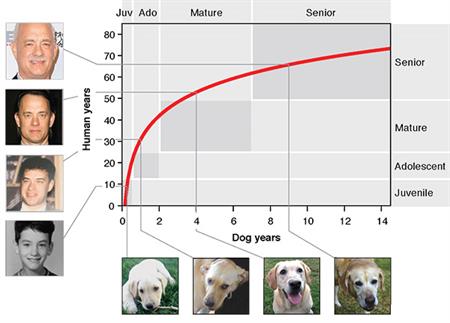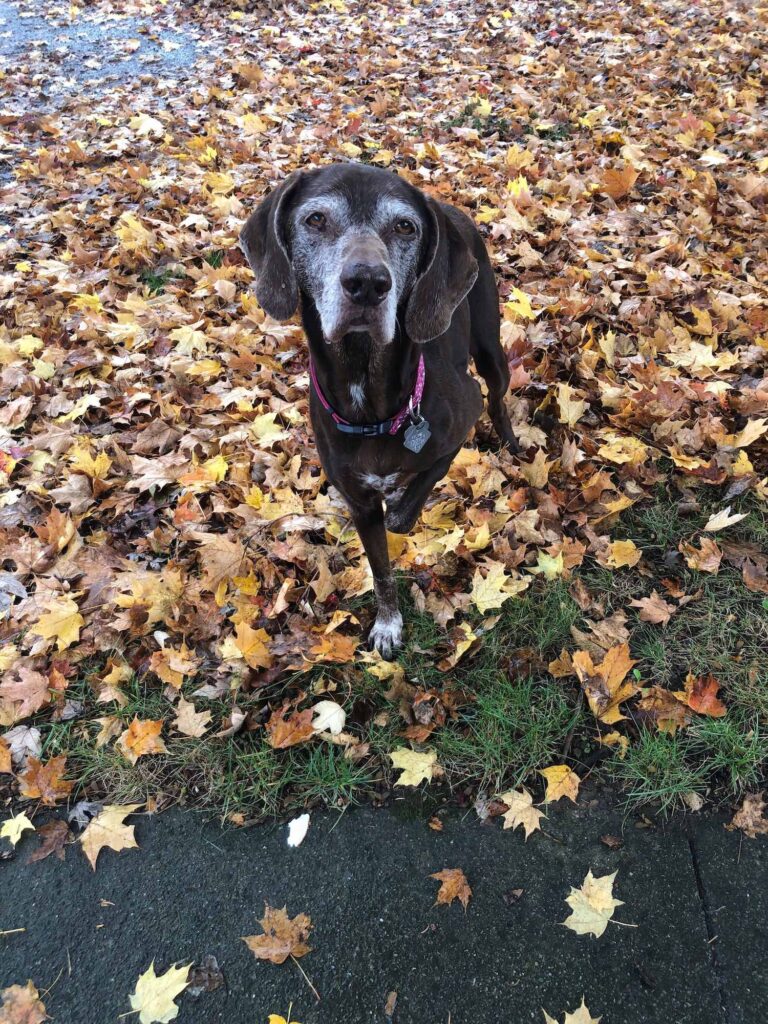Just as ours do, dogs’ bodies change as they get older. But do senior dogs need a different kind of diet than an adult dog? The answer may not be as simple as yes or no. There’s no one-size-fits-all approach to feeding an older dog, and there are also some outdated ideas about what kind of diet suits seniors. So, we’re running down some of the key dietary considerations for the more seasoned pup in your life.
When is my dog considered a senior?
The most common answer to this question is: seven! But aging is different for every dog.
For most dog owners, the answer to “when does my dog become a senior?” is “I know it when I see it.” Just as you recognize the creeping (and then very sudden) effects of time on your own face, hair, and energy levels, you’ll start to notice your dog’s muzzle gaining some dignified grey, and those early morning wake-up calls coming at a more civilized hour.
But it’s actually worth understanding and keeping track of your dog’s life stages so that old age doesn’t appear out of nowhere. If you have a sense of your dog’s “real” age, you can be proactive about nutrition and health, giving them the best chance at retaining their vitality as they get older.
According to the American Animal Hospital Association’s (AAHA) guidelines on life stages, the “senior” stage of life is from maturity to life expectancy (approximately the last 25% of expected lifespan). And a dog is considered “geriatric” if they’ve reached or exceeded their life expectancy. So, if your dog’s breed is predicted to live to 12-14 years old, they’re a senior at about age nine to ten-and-a-half.
As a rule, smaller-breed dogs have longer life expectancies than large and giant-breed dogs. But there are a number of factors that can influence how your dog ages, including genetics, environment, and diet.
For decades, we accepted that one human year was equal to seven dog years; so, if your dog was five, they were “really” 35. But contemporary understanding of how dogs age, and some new research, indicate that the time-worn formula doesn’t add up. The American Veterinary Medical Association states, “contrary to popular belief, dogs do not age at a rate of 7 human years for each year in dog years.”
New math for calculating age
There are a number of different methods of calculating a dog’s “real,” or “human” age. Your veterinarian may assess your dog’s age by examining teeth (more wear and tartar build-up can indicate advanced years), coat, eyes, body condition, and skin laxity. Even with those guidelines, as noted, every dog ages differently.
One recent study offers a new way to look at dog aging relative to human aging. The study looked at chemical changes in dogs’ DNA and found that dogs age way faster than we do in younger years, and then their clock slows down when they’re older.
So, a one-year-old dog is similar to a 30-year-old human.
A four-year-old dog is similar to a 52-year-old human.
And your six-year-old dog is nearly 60 in our years!
By seven years old, dog aging slows. The study found that, at least in the breed studied, which was Labrador retrievers, human and dog life expectancies match up, at 70, and 12 years old, respectively.
So, with a firmer grip on how old your dog really is, you can gain a new appreciation for your six-year-old dog! And you can also gain new appreciation for the importance of good nutrition and health habits through your dog’s “prime,” to keep them spry as they head into their golden years.

New research sheds new light on calculating your dog’s age. Credit: Cell Press.
What to feed your senior
Every dog is different, but the best starting place for any senior is to feed them the highest-quality balanced diet possible. We recommend a diet of fresh, gently cooked food, which provides the easily-digestible nutrients and healthy fats that help maintain all facets of brain and body health.
As dogs get older, their body’s systems may slow down, so balance is really important—providing the right amount of nutrients in the right ratios so you’re not taxing their bodies by depriving them of, or over-supplying certain nutrients. And the more you can provide those nutrients in their natural form–through whole foods—the better.
Fresh, whole food provides some other benefits that are especially relevant to seniors—it’s soft, and easy to eat, and it contains more moisture than dried, heavily-processed pellets, helping to keep your dog’s body hydrated, aiding digestion and elimination.
Managing your dog’s weight is also vital. With a fresh-food plan, you can also ensure portions are tailored to your dog’s specific needs, and you can change portions as those needs change.
The myths of “senior diets”
It’s important to note that the Association of American Feed Control Officials (AAFCO), the organization that sets nutritional standards for pet food, has no official nutrient profile for senior dogs. Pet foods marketed as “senior” formulas usually meet the complete and balanced claim for adult maintenance or all life stages (which is generally the most appropriate for healthy senior pets). So, dog food manufacturers can market any formula as a “senior” dog food, but that particular recipe is not necessarily more appropriate for your senior dog. Some “senior” foods have less protein, less fat, and more carbohydrates than adult diets, but those things may not be relevant to your dog, as we’ll see below.
You shouldn’t feel that as soon as your dog hits that “senior” milestone, you need to switch their food based on age alone. In many cases, a high-quality food for all life stages is a better option than foods marketed as a senior food. It’s a good idea to closely monitor your dog’s health, appetite, and energy, in close consultation with your veterinarian, and proactively make nutritional choices based on what’s best for them now, and as they age.
That said, there’s another myth concerning seniors and diet that’s the flip side of this sudden switch approach—that at a certain point it’s “too late” to switch their food.
“If their needs change, there’s no reason not to switch even a geriatric dog’s food. Even the oldest dogs can benefit from a boost in nutrition and more digestible food.” —Board-certified veterinary nutritionist Dr. Joe Wakshlag, DVM, PhD, DACVN.
Health issues to watch for in senior dogs
There are a number of senior-specific health issues you can keep your eye on that may have an impact on dietary choices.
Changes in digestion
While research has shown that digestive efficiency doesn’t necessarily decrease due to aging itself, there could be a number of factors that contribute to a slowdown in your dog’s ability to digest food.
This means it’s especially important to feed your dog a highly digestible food that provides nutrients that your dog’s body can readily absorb. Studies have shown that fresh, gently cooked food has higher nutrient digestibility than extruded food (aka kibble), which means it’s easier for your dog’s body to actually use the nutrients in the food.
Senior dogs may start showing signs of a sensitive stomach, and they may experience constipation or, on the other end of the spectrum, loose stools. Some “senior diets” are promoted as higher in fiber to address these issues. However, many of these diets include a higher proportion of processed carbs.
A good way to add some extra fiber is to feed a small amount of plain pureed pumpkin, or add some healthy pureed vegetables, like kale or broccoli, to the top of their meals. These natural supplements provide fiber along with nutrients that contribute to overall health.

Weight loss or weight gain
Just like many humans, it’s common for senior dogs to gain weight due to a reduced metabolic rate, and less physical activity.
However, some older dogs may also be prone to losing weight. Some dogs become more frail due to sarcopenia, which is the loss of muscle tissue even when there is no other disease present.
If you have a senior dog who is maintaining body mass and is still relatively active, they likely don’t need fewer calories. But if their body mass drops, along with their activity level, you may need to start to adjust their portions. Work with your vet to assess your dog’s weight and body condition (you can also find a guide to assessing body condition here). For those on a fresh food plan, it’s easy to increase or decrease daily calories based on how your dog is changing over time.
One outdated, yet enduring, belief about senior dogs is that, across the board, they need significantly less protein and fat than adult dogs.
While each dog is different and ages differently, as a rule, unless your dog has a serious condition requiring protein restriction, such as advanced renal disease, reducing protein is not recommended for a healthy senior. In fact, protein is especially important for senior dogs.
The quality of protein is also important to seniors whose bodies may not be functioning with the same efficiency as younger dogs. High-quality, human-grade meat that is lightly cooked, provides digestible protein for aging bodies.
Loss of appetite
Some dogs lose their zest for eating as they age, which can be caused by an underlying medical condition, mouth pain, a loss of some smell and taste, or a number of other factors. If you noticed a marked decrease in your pup’s appetite, be sure to flag it with your veterinarian to root out any bigger problems.
If your dog has simply lost some interest in their food, you can also try adding some food toppers that will add smell and taste appeal, like bone broth, or Parmesan cheese. Bone broth adds enticing flavor and moisture and contains powerful nutrients that can improve the quality and condition of your dog’s coat and skin, as well as support heart, brain, and joint health. Always being mindful of weight and nutrient balance, adding some healthy fruits, like blueberries, or small bits of apple, or vegetables like steamed green beans can also add some excitement and beneficial nutrients.
And if your dog is balking at their dry or canned food, consider switching to fresh, whole food.

Loss of movement/arthritis
While it’s certainly a common ailment–about 20% of adult dogs and up to 90% of senior dogs will show signs of the condition in one or more joints—arthritis is not a foregone conclusion as a dog hits a certain age. Humans develop what is called “primary arthritis”—that means that the joints start to degenerate due to wear and tear that comes with age. Dogs, however, almost always develop secondary arthritis, meaning that there is an abnormality of the joint or other issue associated with it. It’s a condition that typically starts to develop when dogs are younger, but the symptoms show up more dramatically when they are older.
This is another area where proactive health maintenance can make a massive difference. As Dr. Kristin Kirkby Shaw, DVM, MS, PhD, Certified Canine Rehabilitation Therapist, and founder of CARE (Canine Arthritis Resources and Education) told us, “the number one, beyond-a-shadow-of-a-doubt best way to reduce the progression and severity of arthritis is by maintaining a lean body condition.”
Overweight dogs have a much greater chance of developing joint disorders. Multiple studies have shown the link between being overweight and the increased risk and severity of arthritis. And dogs don’t have to be visibly round to be overweight—studies have shown that even a 6% reduction in weight can reduce signs of arthritis.
So, it’s important to keep your dog active, and control weight by making sure you’re feeding the right amount of food, before, and during the senior years.
Quality of food is also important. It’s a good idea to consult your vet on any special dietary requirements, especially if there are any other conditions present, but high quality protein in the right proportion, and foods free of potentially harmful additives can be effective in staving off or minimizing inflammation. “Fresh food is important to help decrease inflammation,” Dr. Lisa Lippman, DVM, has told us. “And fresh food is typically lower in carbs which helps keep weight off our patients.”
Adding Omega-3 fatty acids in the form of whole fish (anchovies or sardines are ideal), or high quality fish oil supplements, can also help decrease inflammation. Omega-3s can help balance Omega-6 fatty acids, which are found in over-abundance in processed foods and most grains. Fish oil contains high concentrations of the important components of Omega-3, eicosapentaenoic acid (EPA) and docosahexaenoic acid (DHA).
Cannabidiol oil has also been used to treat arthritis dogs with positive results. A study from Cornell University College of Veterinary Medicine found that the treatment was safe and effective for dogs with osteoarthritis, with “beneficial effects in…more geriatric patients.” A new study from Baylor University showed reduction in signs of arthritis in dogs treated with CBD (both studies were conducted with involvement from CBD oil companies). With CBD, as with all supplements, make sure you’re consulting your vet, and getting a high-quality product. Pet supplements aren’t regulated by the FDA so many products make false claims about what’s actually in the bottle and recent reports have found some products contained “virtually no” CBD.
Glucosamine and chondroitin sulfate, natural components of cartilage and synovial fluid, play a role in cartilage synthesis, maintenance, and repair and are used to aid in arthritis-related pain. Again, ensure you’re getting the highest quality supplements—low quality supplements of this type can be ineffective or worse—and, as always, consult your vet on whether they’re right for your dog.
Kidney disease
Chronic kidney disease, also called chronic renal failure, involves a reduction in kidney function over time, diminishing the body’s ability to eliminate waste and toxins. Though it can occur in pets at any time, the most common risk factor for canine kidney disease is age.
Often, the first signs of kidney problems are increased thirst and frequent urination. Dogs with kidney disease don’t concentrate urine as well; to compensate, they will be more thirsty and need to urinate more to eliminate the same amount of waste. So hydration is key.
Make sure your dog has constant access to fresh water. Food quality also plays a big role here. Fresh food contains natural moisture, which helps ensure your dog’s fluid intake stays high.
Traditionally, a low protein diet has been recommended for dogs with kidney disease to reduce stress on the kidneys from eliminating nitrogenous waste. But it’s often not as simple as reducing protein. Today, many veterinarians believe that a diet with a normal level of high quality protein is more appropriate and conducive to maintaining overall health for dogs with kidney problems. According to Dr. Wakshlag, a normal amount of protein (as in a healthy, high-quality adult maintenance diet) doesn’t put a strain on the kidneys for a healthy older dog (the issue, he says, is phosphorus, not protein). Only when a dog has significantly reduced kidney function is a reduction in protein recommended. A special diet may be required to reduce stress on the kidneys and slow the progression of the disease. These diets will often be low in phosphorus and sodium, with adjusted calcium-to-phosphorus ratios.
Dogs may also benefit from foods that contain Omega-3 fatty acids, or an Omega-3 supplement in the form of whole sardines, or high-quality fish oil (quality is super important when it comes to fish oil). Some studies have shown that supplementing Omega-3 fatty acids helped reduce the risk of end stage renal disease and reduced protein in the urine of dogs with kidney disease.
Changes in cognition
Changes in dogs’ brain function may show up as memory loss, decreased ability to learn, disorientation, and a shift in demeanor. Again, proactive health management is important in staving off this decline as dogs age.
Providing plenty of physical and mental stimulation and socialization is hugely important throughout a dog’s life. A high-quality diet with antioxidants and healthy fats is also important.
Omega fatty acids, in particular the aforementioned Omega-3s DHA and EPA are important to senior dogs, and DHA in particular is thought to improve brain function in dogs of all ages.
One benefit of a gently cooked fresh diet is that the Omega-3 fats and other beneficial nutrients it contains aren’t destroyed by a high heat manufacturing process so they’re available to your dog’s body. Many commercial pet foods tout Omega-3 content but they may not be delivering the benefits. Fish oil is particularly prone to spoiling or oxidation. In dried kibble, which is designed to sit on shelves for long periods of time, this type of oil goes rancid very quickly. Rancid oil tastes bad, and it’s unhealthy. So this food is not only not providing vital nutrients, it’s causing oxidative stress in your dog’s body which can lead to diseases like cancer.
Another often overlooked brain booster is the naturally occurring antioxidants found in colorful fruits and vegetables. Oxidation is the enemy of all body tissues, including the brain. Dietary antioxidants can be powerful allies in maintaining brain function and overall health. Blueberries, for example, can be a super healthy treat, in moderation.The flavonoid pigments called anthocyanins that give them their color have anti-inflammatory and antioxidant properties—they’ve been shown to help reduce the risk of some cancers, and protect brain cells and memory function. Look for the most naturally vibrantly colored berries, as antioxidant levels vary among blueberries, and other brightly-hued fruits and vegetables.
Green vegetables like broccoli, Brussels sprouts, kale and other leafy greens are rich in phytonutrients, which gives them antioxidant and anti-inflammatory qualities.
Dental disease
Periodontal disease (or gum disease) is a scourge for many dogs, but it tends to really come to the fore in a dog’s senior years. 80% of dogs over three have active dental disease.
Dental disease can of course cause mouth pain, which can interfere with your dog’s ability or desire to eat, and can make them miserable. But dental disease is also linked to other health problems like heart disease and even kidney and liver ailments.
Often dogs don’t show visible signs of dental disease until it’s in an advanced stage. So it’s important to get regular dental exams from your veterinarian, and to take preventative measures, like brushing your dog’s teeth regularly, and feeding a healthy diet.
And while there’s a persistent belief that all kibble helps clean a dog’s teeth, there’s no scientific evidence of that claim. While there are some specially formulated dental diets that support dental health, the idea that typical kibble cleans teeth because it’s hard and crunchy doesn’t hold up. “It’s folklore,” Dr. Jonathan Block, DVM, has told us. “There is no evidence-based research that supports the claim that eating kibble helps prevent dental disease.”
The best food for a senior dog’s overall health is also the best food for their dental health. “I think improving their overall systemic health with a whole-food diet probably improves their microflora and promotes an overall healthier immune system, which will allow them to ward off things like dental infections and be able to tolerate them better,” says Dr. Block.
Change is a constant for all of us. No dog can stay young forever, but simple old age doesn’t have to spell the end of your dog’s active, healthy years.
The best senior care starts before your dog reaches this life stage. You can set your adult dog up for success by keeping them at a lean, healthy weight, and providing tons of appropriate exercise and mental stimulation. As your dog ages, plan regular check-ups with your vet that includes urinalysis, a check on kidney and liver values, and other senior-specific tests. And, throughout their life feed as much healthy, whole food as you can. If you have a new relationship with a senior dog, it’s never too late to provide a diet that’s conducive to better health and many more years.
Pet health is an important topic. That’s why The Farmer’s Dog editorial team carefully vets and reviews every piece of content we publish. We deliver evidence-based advice and medically reviewed facts that focus on pet nutrition, health, and well-being. The mission of this site is to help people provide the best care possible for their dogs by publishing only trustworthy, accurate, and timely health information from a group of passionate experts.
This article was vetted by a vet.
Reviewed by Alex Schechter, DVM, founding veterinarian at Burrwood Veterinary. He was previously founding veterinarian at Pure Paws Veterinary Care.









